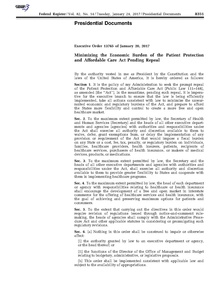Executive Order 13765
| Executive Order Minimizing the Economic Burden of the Patient Protection and Affordable Care Act Pending Repeal | |
 | |
 | |
| Type | Executive order |
|---|---|
| Executive Order number | 13765 |
| Signed by | Donald Trump on January 20, 2017 |
| Federal Register details | |
| Federal Register document number | 2017-01799 |
| Publication date | January 24, 2017 |
| Document citation | 8351 |
| Summary | |
| Directs agencies to hinder parts of Patient Protection and Affordable Care Act (Obamacare) that entail financial burdens, and begin transition to repeal of that law | |
Executive Order 13765 is the first executive order signed by former U.S. President Donald Trump on January 20, 2017, which set out interim procedures in anticipation of repeal of the Affordable Care Act (Obamacare).[1]
The executive order came on Trump's campaign pledges to repeal the Patient Protection and Affordable Care Act, and occurred just hours after he was sworn into office.[2] Trump stated sorting out a replacement will take a long time and the replacement may not be ready until 2018.[3] Following several failed efforts by Congress to pass an alternative to the ACA, Trump issued another executive order in October 2017, the Executive Order to Promote Healthcare Choice and Competition, which some proponents and opponents asserted effectively replaced the ACA with a new healthcare regime.[4][5]
Executive Order 13765 was formally revoked by President Joe Biden on January 28, 2021.[6]
Provisions[]
The order was designed to weaken regulations and procedures associated with enforcement of the Patient Protection and Affordable Care Act.[7][8] It was broken into six sections:
- An attempt to seek efficient implementation of the law, focused on removing regulatory burdens during the repeal of the law.
- The United States Secretary of Health and Human Services and heads of other U.S. executive departments should waive, defer, grant exemptions or delay implementation any requirements of the act that would place fiscal burdens on any State or a cost, fee, tax, penalty, or regulatory burden on individuals, families, healthcare providers, health insurers, patients, recipients of healthcare services, purchasers of health insurance, or makers of medical devices, products, or medications.
- Those department heads are also ordered to grant greater flexibility to states seeking to implement healthcare programs.
- Seeking an open market across state lines in the healthcare market.
- Compliance with the Administrative Procedure Act regarding implementation of the regulatory revisions within this executive order.
- The order does not impact the Office of Management and Budget and its work, does not impact the legal authority of any department head of a U.S. federal agency and does not grant any specific rights to anyone within the United States.
Effects[]
In February 2017, it was reported that the Internal Revenue Service would not require tax filers to state whether they had compliant insurance, allowing them to avoid the penalty fine. The IRS said that this change would reduce administrative burdens on taxpayers. It was criticized for weakening an enforcement mechanism that lowers premiums by supporting wide participation in the markets.[9][10]
See also[]
- Executive Order 13813
- List of executive actions by Donald Trump
- 2017 Patient Protection and Affordable Care Act replacement proposals
References[]
- ^ Knox, Olivier (January 20, 2017). "Trump signs first executive order, targeting Obamacare with few specifics". Sunnyvale, California: Yahoo! News. Retrieved January 21, 2017.
- ^ Davis, Julie Hirschfeld; Pear, Robert (January 20, 2017). "Trump Issues Executive Order Scaling Back Parts of Obamacare". The New York Times. New York City. Retrieved January 23, 2017.
- ^ Trump Appears to Push Back Obamacare Replacement
- ^ Klein, Philip; King, Robert; Leonard, Kimberly (October 9, 2017). "Daily on Healthcare: Trumpcare is coming to an association health plan near you". The Washington Examiner. Washington, D.C.: Clarity Media Group. Archived from the original on October 9, 2017. Retrieved October 12, 2017.
- ^ Schallhorn, Kaitlyn; Gomez, Serafin (October 12, 2017). "Trump clears way for ObamaCare 'alternatives' in new executive order, goes around stalled Congress". Fox News. New York City: Fox Entertainment Group. Retrieved October 12, 2017.
- ^ "Executive Order on Strengthening Medicaid and the Affordable Care Act". January 28, 2021. Retrieved January 28, 2021.
- ^ Office of the Press Secretary (January 20, 2017). "Executive Order Minimizing the Economic Burden of the Patient Protection and Affordable Care Act Pending Repeal". whitehouse.gov. United States: White House. Archived from the original on January 23, 2017. Retrieved January 24, 2017.
- ^ Kodjak, Alison (January 21, 2017). "Trump's Executive Order Could Dismantle Parts Of ACA Before Replacement Is Ready". Washington, D.C.: NPR. Retrieved January 24, 2017.
- ^ Suderman, Peter (February 15, 2017). "Major Blow to Obamacare Mandate: IRS Won't Reject Tax Returns That Don't Answer Health Insurance Question". Reason. Retrieved February 15, 2017.
- ^ Pender, Kathleen (February 14, 2017). "Quiet IRS change could undermine Obamacare, supporters say". San Francisco Chronicle. Retrieved February 15, 2017.
External links[]
| Wikisource has original text related to this article: |
- Executive orders by Trump
- US Presidential Actions
- Office of the Press Secretary - Full Text of the Executive Order (as of January 23, 2017)
- Federal Register
- 2017 in American law
- Executive orders of Donald Trump
- December 2019 events in the United States
- Healthcare reform in the United States
- United States politics stubs